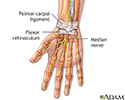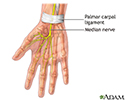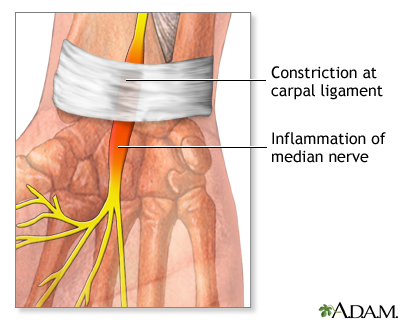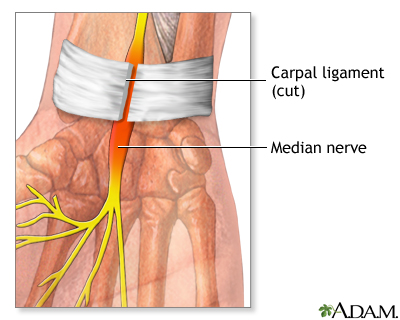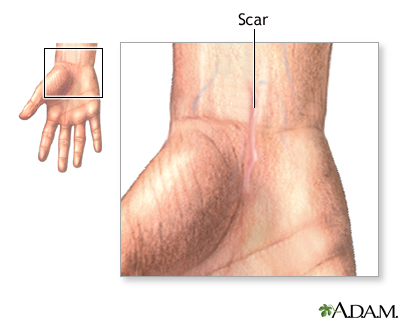Carpal tunnel release
Median nerve decompression; Carpal tunnel decompression; Surgery - carpal tunnel
Carpal tunnel release is surgery to treat carpal tunnel syndrome . Carpal tunnel syndrome is pain and weakness in the hand that is caused by pressure on the median nerve in the wrist.
Carpal tunnel syndrome
Carpal tunnel syndrome is a condition in which there is excessive pressure on the median nerve. This is the nerve in the wrist that allows feeling a...

Description
The median nerve and the tendons that flex (or curl) your fingers go through a passage called the carpal tunnel in your wrist. This tunnel is narrow, so any swelling can pinch the nerve and cause pain. A thick ligament (tissue) just under your skin (the carpal ligament) makes up the top of this tunnel. During the operation, the surgeon cuts through the carpal ligament to make more space for the nerve and tendons.
The surgery is done in the following way:
- First, you receive numbing medicine so that you do not feel pain during surgery. You may be awake but you will also receive medicines to make you relax.
- A small surgical cut is made in the palm of your hand near your wrist.
- Next, the ligament that covers the carpal tunnel is cut. This eases the pressure on the median nerve. Sometimes, tissue around the nerve is removed as well.
- The skin and tissue underneath your skin are closed with sutures (stitches).
Sometimes this procedure is done using a tiny camera attached to a monitor. The surgeon inserts the camera into your wrist through a very small surgical cut and views the monitor to see inside your wrist. This is called endoscopic surgery. The instrument used is called an endoscope.
Why the Procedure Is Performed
People with symptoms of carpal tunnel syndrome usually try nonsurgical treatments first. These may include:
- Anti-inflammatory medicines
- Therapy to learn exercises and stretches
- Workplace changes to improve your seating and how you use your computer or other equipment
- Wrist splints
- Shots of corticosteroid medicine into the carpal tunnel
If none of these treatments help, some surgeons will test the electrical activity of the median nerve with an EMG (electromyogram). If the test shows that the problem is carpal tunnel syndrome, carpal tunnel release surgery may be recommended.
EMG
Electromyography (EMG) is a test that checks the health of the muscles and the nerves that control the muscles.

If the muscles in your hand and wrist are getting smaller because the nerve is being pinched, surgery will usually be done soon.
Risks
Risks of this surgery are:
- Allergic reactions to medicines
-
Bleeding
Bleeding
Bleeding is the loss of blood. Bleeding may be:Inside the body (internally) Outside the body (externally)Bleeding may occur:Inside the body when blo...
 ImageRead Article Now Book Mark Article
ImageRead Article Now Book Mark Article - Infection
- Injury to the median nerve or nerves that branch off of it
- Weakness and numbness around the hand
- In rare case, injury to another nerve or blood vessel (artery or vein)
- Scar tenderness
Before the Procedure
Tell your health care provider what medicines you are taking. This includes medicines, supplements, or herbs you bought without a prescription.
- You may be asked to stop taking drugs that affect your blood's ability to clot. These include aspirin, ibuprofen (Advil, Motrin), naproxen (Naprosyn, Aleve), and other drugs.
- Ask your provider which medicines you should still take on the day of your surgery.
- If you smoke, try to stop. Ask your provider for help. Smoking can slow healing.
- Let your provider know about any cold, flu, fever, herpes breakout, or other illness you may have before your surgery.
- Follow instructions about whether you need to stop eating or drinking before surgery.
- Your provider will tell you when to arrive at the hospital for the procedure. Arrive on time.
After the Procedure
This surgery is done on an outpatient basis. You will not need to stay in the hospital.
After the surgery, your wrist will probably be in a splint or heavy bandage for about a week. Keep this on until your first doctor visit after surgery, and keep it clean and dry. After the splint or bandage is removed, you will begin motion exercises or a physical therapy program.
Outlook (Prognosis)
Carpal tunnel release decreases pain, nerve tingling, and numbness, and restores muscle strength. Most people are helped by this surgery.
The length of your recovery will depend on how long you had symptoms before surgery and how badly damaged your median nerve is. If you had symptoms for a long time, you may not be completely free of symptoms after you recover.
References
Calandruccio JH. Carpal tunnel syndrome, ulnar tunnel syndrome, and stenosing tenosynovitis. In: Canale ST, Beaty JH, eds. Campbell's Operative Orthopaedics . 12th ed. Philadelphia, PA: Elsevier Mosby; 2013:chap 76.
Mintalucci DJ, Leinberry Jr. CF. Open versus endoscopic carpal tunnel release. Orthop Clin N Am . 2012;43:431-7. PMID: 23026458 www.ncbi.nlm.nih.gov/pubmed/23026458 .
Zhao M, Burke DT. Median neuropathy (carpal tunnel syndrome). In: Frontera WR, Silver JK, Rizzo TD Jr, eds. Essentials of Physical Medicine and Rehabilitation: Musculoskeletal Disorders, Pain, and Rehabilitation . 3rd ed. Philadelphia, PA: Elsevier Saunders; 2015:chap 36.
-
Carpal tunnel syndrome - illustration
Carpal tunnel syndrome is becoming more frequently recognized and may be occurring more often. It may result from repetitive motion or the use of devices like computer keyboards. It affects the median nerve, the nerve that supplies feeling and movement to the thumb and "thumb-side" of the hand.
Carpal tunnel syndrome
illustration
-
Surface anatomy - normal palm - illustration
This picture shows the normal appearance of an adult's palm and fingers.
Surface anatomy - normal palm
illustration
-
Surface anatomy - normal wrist - illustration
This picture shows a normal flexed hand. The tendons that move the fingers and are associated with carpal tunnel syndrome are visible just below the wrist.
Surface anatomy - normal wrist
illustration
-
Wrist anatomy - illustration
The median nerve travels through a compartment called the carpal tunnel in the wrist. The ligaments that transverse the nerve are not very flexible. If there is any swelling within the wrist compartment excessive pressure can be put on structures such as the blood vessels and the median nerve. Excessive pressure can constrict bloodflow and cause nerve damage. The symptoms from the compression causes pain, loss of sensation, and decreased function in the hand.
Wrist anatomy
illustration
-
Carpal tunnel repair - series
Presentation
-
Carpal tunnel syndrome - illustration
Carpal tunnel syndrome is becoming more frequently recognized and may be occurring more often. It may result from repetitive motion or the use of devices like computer keyboards. It affects the median nerve, the nerve that supplies feeling and movement to the thumb and "thumb-side" of the hand.
Carpal tunnel syndrome
illustration
-
Surface anatomy - normal palm - illustration
This picture shows the normal appearance of an adult's palm and fingers.
Surface anatomy - normal palm
illustration
-
Surface anatomy - normal wrist - illustration
This picture shows a normal flexed hand. The tendons that move the fingers and are associated with carpal tunnel syndrome are visible just below the wrist.
Surface anatomy - normal wrist
illustration
-
Wrist anatomy - illustration
The median nerve travels through a compartment called the carpal tunnel in the wrist. The ligaments that transverse the nerve are not very flexible. If there is any swelling within the wrist compartment excessive pressure can be put on structures such as the blood vessels and the median nerve. Excessive pressure can constrict bloodflow and cause nerve damage. The symptoms from the compression causes pain, loss of sensation, and decreased function in the hand.
Wrist anatomy
illustration
-
Carpal tunnel repair - series
Presentation
-
Carpal tunnel syndrome
(In-Depth)
Review Date: 5/9/2015
Reviewed By: C. Benjamin Ma, MD, Assistant Professor, Chief, Sports Medicine and Shoulder Service, UCSF Department of Orthopaedic Surgery, San Francisco, CA. Also reviewed by David Zieve, MD, MHA, Isla Ogilvie, PhD, and the A.D.A.M. Editorial team.




